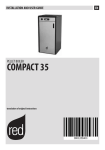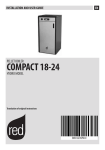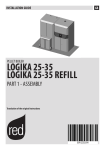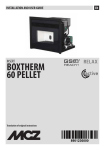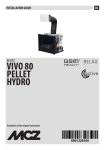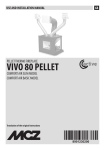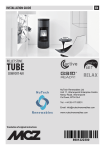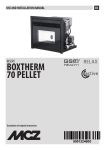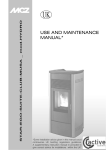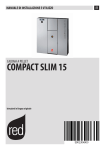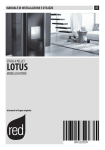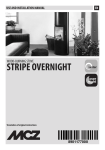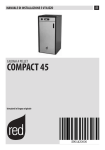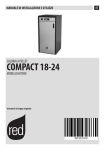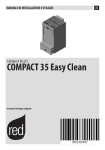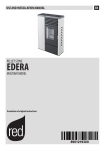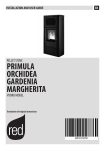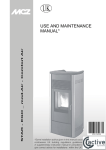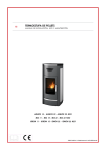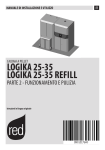Download Mcz Compact 18 Wood Pellet Boiler – User Manual
Transcript
INSTALLATION AND USER GUIDE PELLET BOILER COMPACT 18-24 HYDRO MODEL Translation of original instructions EN TABLE OF CONTENTS INTRODUCTION .............................................................................................. 1 1-WARNINGS AND WARRANTY TERMS. . ............................................................. 2 2-INSTALLATION INSTRUCT............................................................................. 6 3-DRAWINGS AND TECHNICAL SPECIFICATIONS. . ...............................................14 4-INSTALLATION AND ASSEMBLY. . ...................................................................16 5-PLUMBING CONNECTION.............................................................................19 6-ELECTRICAL CONNECTIONS. . ........................................................................22 7-INITIAL START-UP......................................................................................23 8-MENU ITEMS..............................................................................................26 9-PRELIMINARY NOTIONS..............................................................................32 10-OPERATION..............................................................................................36 11-SAFETY DEVICES AND ALARMS...................................................................42 12-MAINTENANCE AND CLEANING...................................................................46 13-PROBLEMS/CAUSES/SOLUTIONS.................................................................52 14-WIRING DIAGRAM....................................................................................55 II INTRODUCTION Dear Customer, Thank you for having chosen our product. To allow for optimal operation and for you to enjoy the warmth and sense of wellbeing that the fire can convey in your home, we advise you to read this manual carefully before starting up the product for the first time. REVISIONS TO THE PUBLICATION The content of this manual is strictly technical and property of MCZ Group Spa. No part of this manual can be translated into another language and/or altered and/or reproduced, even partially, in another form, by mechanical or electronic means, photocopied, recorded or similar, without prior written approval from MCZ Group Spa. The company reserves the right to make changes to the product at any time without prior notice. The proprietary company reserves its rights according to the law. CARE OF THE MANUAL AND HOW TO CONSULT IT • • • • • Take care of this manual and keep it in an easily accessible place. Should the manual be misplaced or ruined, request a copy from your retailer or directly from the authorised Technical Assistance Department. “Bold text” requires particular attention. “Text in “italics” is used to draw your attention to other paragraphs in this manual or any additional explanation. “NOTE” provides the reader with additional information. SYMBOLS USED IN THE MANUAL ATTENTION: carefully read and understand the relative message because failure to comply with what is written can cause serious damage to the product and put the user’s safety at risk. INFORMATION: failure to comply with these provisions will compromise the use of the product. OPERATING SEQUENCES: sequence of buttons to be pressed to access the menus or make adjustments. MANUAL carefully read this manual or the relative instructions. Technical Dept. - All rights reserved - Reproduction is prohibited 1 1-WARNINGS AND WARRANTY TERMS SAFETY PRECAUTIONS • Installation, electrical connection, functional verification and maintenance must only be performed by qualified or authorised personnel. • Install the product in accordance with all the local and national laws and Standards applicable in the relative place, region or country. • This product is not intended for use by persons (including children) with reduced physical, sensory or mental capabilities, or lack of experience and knowledge, unless they are supervised or trained on how to use the product by a person responsible for their safety. • Only use fuel recommended by the company. The product must not be used as an incinerator. It is strictly forbidden to use liquid fuel. • The instructions provided in this manual must always be complied with to ensure the product and any electronic appliances connected to it are used correctly and accidents are prevented. • The user, or whoever is operating the product, must read and fully understand the contents of this installation and use guide before performing any operation. Errors or incorrect settings can cause hazardous conditions and/or poor operation. • Do not use the product as a ladder or supporting structure. • Do not place laundry on the product to dry. Any clothes horses or similar objects must be kept at a safe distance from the product. Fire hazard. • All liability for improper use of the product is entirely borne by the user and relieves the Manufacturer from any civil and criminal liability. • Any type of tampering or unauthorised replacement with non-original spare parts could be hazardous for the operator’s safety and relieve the company from any civil and criminal liability. • Most of the surfaces of the product are very hot (door, handle, glass, smoke outlet pipes, etc.). Avoid contact with these parts unless adequate protective clothing is worn or appropriate means are used, such as heat protective gloves or cold handle type operating systems. • It is forbidden to operate the product with the door open or the glass broken. • The product must be powered by a system that is equipped with an effective earth system. • Switch the product off in the event of a fault or malfunctioning. • Accumulated unburned pellets in the burner after each “failed start-up” must be removed before starting up again. • Do not wash the product with water. The water could get inside the unit and damage the electrical insulation and cause electric shocks. • Do not stand in front of the product for a long time. Do not overheat the room where the product is installed. This could cause injuries and health problems. • Do not put any fuel other than wood pellets in the hopper. • Install the product in rooms that are adequately protected against fire and equipped with all the utilities such as supplies (air and electricity) and smoke outlets. • If a fire breaks out inside the chimney, switch the appliance off, disconnect it from the mains and do not open the door. Then contact the competent authorities. • The product and the ceramic/serpentine cladding must be stored in a place where there is no humidity and must not be exposed to the elements. • It is recommended not to remove the feet that support the product in order to guarantee adequate insulation, especially if the flooring is made of flammable material. • If the ignition system is faulty, do not force ignition with flammable materials. • Special maintenance must only be performed by authorised and qualified personnel. • Assess the static conditions of the surface on which the weight of the product will rest and provide suitable insulation if it is made of flammable material (e.g. wood, fitted carpet or plastic). 2 1-WARNINGS AND WARRANTY TERMS INFORMATION: Please contact the retailer or qualified personnel authorised by the company to resolve a problem. • only fuel stipulated by the company must be used. • Check and clean the smoke outlet pipes regularly (connection with the product). • The product is not a cooking appliance. • Always keep the cover of the fuel hopper closed. • Keep this instruction manual in a safe place as it must accompany the product throughout its working life. If it is sold or transferred to another user, always make sure that the manual accompanies the product. INTENDED USE The product only works with wood pellets and must be installed indoors. WARRANTY CONDITIONS The company provides a product warranty, excluding the parts subject to normal wear stipulated below, for a period of two years from the date of purchase, which is proven by a supporting document that contains the name of the seller and the date when the sale took place. Warranty cover is valid if the completed warranty is returned within 8 days and the product is installed and tested by a qualified installer, according to the detailed instructions provided in the instruction manual supplied with the product. The term ‘warranty’ refers to the (free-of-charge) replacement or repairs of parts acknowledged to be faulty due to manufacturing defects. RESTRICTIONS The above-mentioned warranty does not cover parts of electrical and electronic components and fans, which are covered for 1 year from when the product is purchased, proof of which is provided as specified above. The warranty does not cover parts subject to normal wear, such as: gaskets, glass and all parts that can be removed from the firebox. Replaced parts will be covered by the warranty for the remaining period of the warranty in force as from the date of purchase of the product. EXCLUSIONS Variations in colour of the painted or ceramic/serpentine parts and crazed ceramics do not constitute grounds for a claim as they are natural characteristics of the material and product use. The warranty does not cover any part that may be faulty as a result of negligence or careless use, incorrect maintenance or installation that does not comply with the company’s instructions (see the relative chapters in this user manual). The company declines all liability for any damage which may be caused, directly or indirectly, to persons, animals or objects as a consequence of non compliance with all the prescriptions specified in the manual, especially warnings regarding installation, use and maintenance of the appliance. If the product does not work correctly, contact your local retailer and/or importer. Damage caused during transport and/or when handled is excluded from the warranty. The supplied installation guide is the only reference for installation and product use. The warranty will be rendered null and void in the event of damage caused by tampering, atmospheric agents, natural disasters, electrical discharges, fire, defects in the electrical system, and maintenance not being performed at all or as indicated by the manufacturer. Technical Dept. - All rights reserved - Reproduction is prohibited 3 1-WARNINGS AND WARRANTY TERMS INTERVENTION REQUEST The company declines all liability if the product and any other accessory is used incorrectly or altered without authorisation. All parts must be replaced with original spare parts. The request must be sent to the retailer who will forward it to the Technical Assistance Service. SPARE PARTS Only use original spare parts. The retailer or service centre can provide all the useful information regarding spare parts. It is recommended not to wait for the parts to be worn before having them replaced. It is important to perform regular maintenance. PRECAUTIONS FOR CORRECT DISPOSAL OF THE PRODUCT IN ACCORDANCE WITH THE EUROPEAN DIRECTIVE 2002/96/EC AND ITS SUBSEQUENT AMENDMENT 2003/108 EC. At the end of its working life, the product must not be disposed of as urban waste. It must be taken to a special differentiated waste collection centre set up by the local authorities or to a retailer that provides this service. Disposing of the product separately prevents possible negative consequences for the environment and health deriving from inappropriate disposal and allows to recycle its materials in order to obtain significant savings in energy and resources. As a reminder of the need to dispose of appliances separately, the product is marked with a crossed-out wheeled dustbin. 4 1-WARNINGS AND WARRANTY TERMS INSTALLATION INSTRUCTIONS The product is a boiler designed for operation with wood pellets. It must be installed in compliance with the regulations listed below: Legislative Decree no. 93 of 25 February 2000 Implementation of Directive 97/23/EC (PED) in the field of pressure equipment. FIELD OF APPLICATION: appliances powered by liquid (fuel-oil, diesel, oil) and solid fuels. LAW No. 46 of 5 March 1990 and its implementing regulation Presidential Decree No. 447 of 6 December 1991 (and subsequent amendments) and Ministerial Decree No. 37 of 22 January 2008 Standards for the safety of installations FIELD OF APPLICATION: with unlimited heat potential. Standard UNI 10847 of 03/2000 Single flue systems for generators powered with solid and liquid fuels. Maintenance and inspection. Guidelines and procedures. FIELD OF APPLICATION: systems powered with solid and liquid fuels. LAW No. 10 of 9 January 1991 and its implementing regulation Presidential Decree No. 412 of 26 August 1993 (and subsequent amendments), Presidential Decree No. 551 of 21 December 1999. Regulation amending Presidential Decree 412 relating to the design, installation, operation and maintenance of thermal systems of buildings, in order to control energy consumption. FIELD OF APPLICATION: with unlimited heat potential. LAW No. 186 of 01.03.1968 Installation standard CEI 64-8 / II ed. Electrical installations with rated voltage not exceeding 1000 V alternating current and 1500 V direct current. Installation standard CEI 64-8 / I ed. Electrical installations in buildings for residential use and the like. Standard UNI 10683 of 09/2005 Systems fuelled with wood or other solid biofuels. Installation requirements FIELD OF APPLICATION: systems fuelled with wood or other solid biofuels with firebox thermo-chemical power below 35 kW. The installation procedure requires the heating system diagram, prepared in compliance with the standard and local recommendations in force as follows: • For the heating system - EN 303-5/2000 - “Heating boilers. Part 5: Heating boilers for solid fuels, hand and automatically stoked, with a nominal heat output of up to 300 kW. Terminology, requirements, testing and marking”. • Local requirements for the connection to the chimney. • Local requirements for fire regulations. • For the power circuit - EN 60335-1/2008- “Safety of household and similar electrical appliances, Part 1 - General Requirements”. This appliance must be installed in compliance with the standards in force when installing the boiler. Technical Dept. - All rights reserved - Reproduction is prohibited 5 2-INSTALLATION INSTRUCT The requirements in this chapter refer to the regulations of the Italian installation Standard UNI 10683. In any case, always comply with the regulations in force in the country of installation PELLETS Wood pellets are manufactured by hot-extruding compressed sawdust which is produced during the processing of natural dried wood (without paints). The compactness of the material is guaranteed by the lignin contained in the wood itself and allows pellets to be produced without glue or binders. The market offers different types of pellets with characteristics that vary according to the wood mixtures used. The diameter varies between 6 and 8 mm, with a standard length ranging from 5 to 30 mm. Good quality pellets have a density that varies between 600 and over 750 kg/m3, with a moisture content that ranges from 5% to 8% of its weight. Pellets have technical advantages besides being an ecological fuel, as the wood residue is used completely, thereby achieving cleaner combustion than that of fossil fuels. Good-quality wood has a calorific value of 4.4 kW/kg (15% moisture, after about 18 months of seasoning), whereas that of pellets is 4.9 kW/kg. To ensure good combustion, the pellets must be stored in a dry place and protected from dirt. Pellets are usually supplied in 15 kg bags, therefore, storing them is very convenient. Good quality pellets guarantee good combustion, thereby decreasing harmful emissions into the atmosphere. 15 Kg BAGS OF FUEL The poorer the quality of the fuel, the more often the internal parts of the brazier and combustion chamber must be cleaned. DINplus, Ö-Norm M7135 and Pellet gold are examples of the major quality certifications of pellets in the European market and guarantee that the following are complied with: • • • • • • • calorific value: 4.9 kWh/kg. Water content: max 10% of the weight. Percentage of ash: max 0.5% of the weight. Diameter: 5 – 6 mm. Length: max 30 mm. Content: 100% untreated wood with no added binding agents (max percentage of bark: 5%). Packaging: in bags made from environmentally friendly or biologically decomposable material. The company strongly recommends using certified fuel for its products (DINplus, Ö-Norm M7135 or Pellet Gold). Poor quality pellets or others that do not comply with that specified previously compromises the operation of your product and can therefore render the warranty and product liability null and void. 6 2-INSTALLATION INSTRUCT PRECAUTIONS REGARDING INSTALLATION IMPORTANT! Product installation and assembly must be carried out by qualified personnel. The product must be installed in a suitable place for it to be regularly opened and routine maintenance to be performed. The site must be: • compliant for proper operation. • Equipped with an adequate smoke expulsion system. • Equipped with ventilation intake from outside. • Equipped with 230V 50 Hz power supply with an EC compliant earth system. The product must be connected to a chimney or an internal or external vertical duct that complies with the regulations in force. The product must be positioned in such a way that the electrical socket is accessible. IMPORTANT! The product must be connected to a chimney or a vertical duct that can expel the smoke at the highest point of the building. In any case smoke derives from combustion of types of wood and if it comes in contact with or close to walls, these can become dirty. Moreover, utmost attention is required as they are almost invisible but very hot and can cause burns. The holes of the external air inlet and the smoke outlet pipe must be drilled before positioning the product. THE OPERATING ENVIRONMENT For correct operation and even distribution of heat, the product must be placed where the air required for combustion can flow. The volume of the room should be no less than 15 m3. Air must enter through permanent openings made in the walls (near the product) that reach outwards with a minimum section of 100 cm2 without the protective grille (in the case of a non-Oyster installation, i.e. without external ducted combustion air). These openings (air inlets) must be made in such a way that it is impossible for them to be obstructed in any way. Air can also be drawn from adjacent rooms to the one that is to be ventilated, provided they have an external air inlet and are not used as a bedroom or bathroom or where there is a fire hazard, such as: garages, timber storerooms, warehouses of flammable materials, observing under all circumstances the provisions of all the applicable standards in force. If the product is placed too close to the wall it could cause overheating and damage the plaster (yellowing, cracking, etc.). Technical Dept. - All rights reserved - Reproduction is prohibited 7 2-INSTALLATION INSTRUCT POSITIONING AND RESTRICTIONS In the case of simultaneous installation with other heating appliances, provide appropriate air inlets for each one (according to the instructions of each product). The product cannot be installed (except for sealed or closed operation appliances with external ducted combustion air intake): • in bedrooms or bathrooms; • in rooms where there are liquid fuel appliances with continuous or intermittent operation that draw the combustion air from the room they are installed in; • in rooms where there are B-type gas heating appliances, with or without domestic hot water production and interconnecting rooms; • where another heating appliance is installed without an independent air flow. It is forbidden to place the product in an explosive atmosphere. BOILER ROOM Check that the room meets the requirements and characteristics in compliance with the standards in force. The room must also have suitable ventilation required for proper combustion. One must therefore make openings in the room walls that meet the following requirements: • They must have a section of at least 6 cm2 per each 1 kW (859.64 kcal/h). The minimum opening section must in any case not be below 100 cm2. The section may also be calculated using the following relation: S = K * Q ≥ 100 cm2 Where “S” is expressed in cm2, “Q” in kW, “K” = 6 cm2/kW • The opening must be positioned in the lower part of an outer wall, preferably opposite to that in which the smoke evacuation duct is located. MINIMUM DISTANCES Room ventilation can only be set towards the rear wall if there is adequate insulated ducting of the hot air flow. COMPACT 18-24 Hydro Non-flammable walls A = 2 cm B = 15 cm Flammable walls A = 2 cm B = 20 cm If particularly delicate objects are present, such as furniture, curtains or sofas the distance of the product must be significantly increased. If the floor is made of wood, it is recommended to place a floor protection in accordance with the Standards in force in the country of installation. Heat-sensitive or flammable objects cannot be placed near the product. Keep such objects at a minimum distance of 80 cm from the outermost point of the product. 8 2-INSTALLATION INSTRUCT CONNECTION OF THE SMOKE EXHAUST DUCT When making the hole for the passage of the smoke discharge pipe, one must take into account the possible presence of flammable materials. If the hole must be made through a wooden wall or thermolabile material, the INSTALLER MUST first of all use the appropriate wall fitting (minimum diameter 13 cm) and suitably insulate the pipe of the product that passes through it using adequate insulating materials (1.3 - 5 cm thick with minimum thermal conductivity 0.07 W/m°K). The same minimum distance must be applied if the pipe of the product must pass through vertical or horizontal sections near the thermolabile wall. It is recommended to use an insulated double-wall pipe in external sections in order to prevent condensation from forming. The combustion chamber works in negative pressure. 2 1 REAR VIEW OF A PELLET BOILER (EXAMPLE) 1) SMOKE OUTLET 2) COMBUSTION AIR INLET Technical Dept. - All rights reserved - Reproduction is prohibited 9 2-INSTALLATION INSTRUCT Always use pipes and fittings with appropriate seals that guarantee tightness. It must be possible to inspect all sections of the flue duct and they must be removable for periodic internal cleaning (T-fitting with inspection hole). Position the product considering all the above requirements and instructions. IMPORTANT! The following conditions must be complied with when connecting the appliance to the chimney: • the smoke duct must be at least category T200 (or higher if required by the smoke temperature of the appliance) and P1-type (airtight). • All 90° angles (max. 3) in the smoke exhaust duct must be preferably fitted with the relative T-fittings with inspection hole. (See pellet product accessories). • It is strictly forbidden to fit a mesh at the end of the exhaust pipe as it could cause the product to malfunction (due to clogging). • It is forbidden to use counter-sloping pipes. • The horizontal section of the smoke duct must not be longer than 2-3 m. • It is also recommended not to exceed 6 metres in length with the pipe Ø 80 mm. • The smoke duct must not cross rooms in which it is forbidden to install combustion appliances. PELLET BOILER INSTALLATION EXAMPLE COMBUSTION AIR (2) During operation a certain amount of air is drawn from the room in which the product is installed and this air must be supplemented through an external air inlet. 10 2-INSTALLATION INSTRUCT CONNECTION TO THE EXTERNAL AIR INLET It is essential for the room where the product is installed to be adequately ventilated in order to guarantee sufficient air for proper combustion in the appliance. This is possible by means of suitable ventilation openings in the room itself or in an interconnected room through a permanent opening between the rooms (room ventilation is excluded in the case of installation with Oyster technology, where combustion air is ducted directly from outside) For this purpose, drill a hole on the outer wall close to the product with a minimum section of 80 cm² (11 cm in diameter or 10x10 cm if rectangular, considering the protective grids), protected by a grid on the outside. The air inlet must also: • be protected with a grid, metal mesh, etc. without reducing the net section. • Be positioned in such a way so as not to be obstructed. • Allow maintenance to be performed. • Be directly interconnected with the room where the product is installed. • In the case of ducting, up to 3.5 linear metres, increase the cross-section by about 5%, whereas for longer ducts, increase it by 15%. Remember that the ventilation grilles always show the useful section in cm2 on one side. When choosing the grille and size of the hole, check that the useful section of the grille is larger or equal to the section required by the company for product operation. IMPORTANT! The air flow can also be drawn from an adjacent room to that of the room where the product is installed, provided the air can flow freely through permanent openings interconnected with the outside; air inlets connected to thermal units, garages, kitchens or bathrooms must be avoided. CONNECTION TO THE CHIMNEY The chimney is the fundamental element for smoke expulsion and must therefore comply with the following requirements: • be waterproof and thermally insulated. • Be made of suitable materials that resist mechanical stress over time, heat, the effects of the combustion products and any possible condensation. • Have a vertical set-up with deviations from the axis of no more than 45° and free of bottlenecks. • Must be suitable for the specific operating conditions of the product and have the CE marking (EN1856-1, EN1443). • Must be adequately sized for the draught/smoke expulsion requirements that are necessary for the product to operate correctly (EN13384-1). • The internal section is preferably circular. • In the case of a pre-existing product that has been used, it must be cleaned. • The chimney must not be shared with other appliances. The chimney is fundamental for correct operation and safety of your product. Hereunder are a few guidelines for a correct installation. Any alternative configurations must be suitably sized in accordance with the general method of calculation of UNI EN 13384-1. Technical Dept. - All rights reserved - Reproduction is prohibited 11 2-INSTALLATION INSTRUCT CONNECTIONS CONNECTION TO THE CHIMNEY CONNECTION TO AN EXTERNAL DUCT WITH AN INSULATED OR DOUBLE-WALL PIPE CONNECTION TO THE CHIMNEY The chimney's internal dimensions must not exceed 20x20 cm or 20 cm diameter; in the event of bigger sizes or bad chimney conditions (e.g. cracks, poor insulation, etc.), it is advisable to fit a stainless steel pipe of suitable diameter throughout the length of the chimney right to the top. The minimum internal dimensions of the external duct must be 10x10 cm or 10 cm in diameter and must not exceed 20x20 cm or 20 cm in diameter. Only stainless steel insulated (doublewall) pipes must be used, which are smooth on the inside and fixed to the wall. Flexible stainless steel pipes must not be used. The connection between the product and the chimney or the smoke duct must not have an inclination that is less than 3% in the horizontal sections, which must have a maximum overall length of 2/3 m. The vertical section between one T-fitting and another (angle) must not be less than 1.5 m. mt.0,5 mt.0,5 mt. 1 1 1 0,5 mt.0,5 mt.0,5 mt. 1 1 1 0,5 mt.0,5 mt.0,5 mt. 1 2 - 3 mt. 2 -MAX 3 mt. 2 - MAX 3 mt. MAX 1) WINDPROOF CHIMNEYPOT • • • • • 12 2) CHIMNEY 3 2 3 2 3 2 3 2 2 3 3 3-5 % 3-5 % 3-5 % H > 1,5 mt. 3 2 H > 1,5 mt. 3 2 H > 1,5 mt. 2 1 3) INSPECTION HOLE Use adequate instruments to verify that there is a minimum draught of 5 Pa. Set-up an inspection hole at the bottom of the chimney to perform periodic checks and cleaning, which must be done annually. The connection to the chimney must be sealed and the fittings and pipes recommended by us must be used (CE marked in accordance with EN1856-2 with the minimum requisites: T200 and P1). You must ensure that a windproof chimneypot is installed in accordance with the regulations in force. This type of connection guarantees smoke expulsion even in the event of a temporary power cut. 1 3 2-INSTALLATION INSTRUCT OPERATING PROBLEMS RELATED TO DRAUGHT DEFECTS IN THE CHIMNEY Among all the weather and geographical conditions that affect chimney operation (rain, fog, snow, altitude a.s.l., exposure to sunlight, orientation to the cardinal points, etc.), the wind is certainly the most determinant. In fact, besides the thermal depression caused by the difference in temperature between inside and outside the chimney, there is another type of depression (or overpressure): dynamic pressure caused by the wind. An updraft always increases depression and therefore the draught. A horizontal wind increases depression provided the chimneypot has been installed properly. A downdraft always decreases depression, at times inverting it. A B A=LESS FAVOURABLE POINTS B=MOST FAVOURABLE POSITION Besides the direction and force of the wind, the position of the chimney and the chimneypot with respect to the roof of the building and the surrounding landscape is also important. The wind also affects chimney operation indirectly by creating overpressure and depression zones within the building as well as outside. An internal overpressure can be created in rooms that are directly exposed to the wind (2), which can enhance the draught in boilers and fireplaces, however, it can be counteracted by the external overpressure if the chimneypot is situated on the side exposed to the wind (1). On the other hand, a dynamic depression can be created in rooms that are opposite the wind direction (3), which competes with the natural thermal depression generated by the chimney, however, this can be compensated for (sometimes) by placing the smoke duct opposite the wind direction (4). IMPORTANT! The operation of the pellet product is significantly affected by the chimney layout and position. Hazardous conditions can only be resolved by qualified personnel setting the product appropriately. WIND 1 4 2 Technical Dept. - All rights reserved - Reproduction is prohibited 3 13 3-DRAWINGS AND TECHNICAL SPECIFICATIONS DRAWINGS AND CHARACTERISTICS LOTUS HYDRO DIMENSIONS (in cm) 14 3-DRAWINGS AND TECHNICAL SPECIFICATIONS TECHNICAL CHARACTERISTICS COMPACT 18 HYDRO COMPACT 24 HYDRO Type of fuel: Pellets Pellets Max nominal output power (total/water): 18.1 kw / 15566 kcal / 17 kw H2O/ 14620 kcal 24.5 kW / 21,070 kcal / 22.1 kW / 19,006 kcal Minimum output power: 4.3 kw / 3,698 kcal / 3.8 kw H2O/ 3,268 kcal 4.3 kW / 3,698 kcal / 3.8 kW / 3,268 kcal Efficiency at Max 93,8% 90,2% Efficiency at Min 88,5% 88,5% Temperature of exhaust smoke at Max 120 °C 150°C Temperature of exhaust smoke at Min 65 °C Particulate/OGC / Nox (13%O2) 29.3 mg/Nm - 2.7 mg/Nm 135.2 mg/ Nm3 (13% O2) 17.8 mg/Nm3 - 0.1 mg/Nm3 - 132 mg/ Nm3 (13% O2) CO at 13% O2at Min and at Max 0,021% – 0,017% 0,021 - 0,010% CO2 at Min and at Max 5,9% - 9,2% 5,9 - 9,0% Recommended draught at Max power 0.10 mbar - 10 Pa 0.10 mbar - 10 Pa Recommended draught at Min power 0.05 mbar - 5 Pa 0.05 mbar - 5 Pa Mass of smoke at Min and at Max 4.9 - 12.7 g/sec 4.9 - 17.5 g/sec Hopper capacity 100 litres 100 litres Type of pellet fuel Pellet diameter 6-8 mm and size 5/30 mm Pellet diameter 6-8 mm and size 5/30 mm Pellet hourly consumption Min ~ 1 kg/h* - Max ~ 3.6 kg/h* Min ~ 1 kg/h* - Max ~ 4.8 kg/h* Autonomy At min ~ 68 h* - At max ~ 19 h* At min ~ 68 h* - At max ~ 15 h* Water content 25 litres 25 litres Maximum operating pressure 3 bar 3 bar Combustion air inlet External diameter 80 mm External diameter 80 mm Smoke outlet External diameter 100 mm External diameter 100 mm Electrical power consumption Max 430 W - Med. 180 W Max 430 W - Med. 180 W Supply voltage and frequency 230 Volt / 50 Hz 230 Volt / 50 Hz Net weight 200 kg 200 kg Weight with packaging 220 kg 220 kg 65°C 3 3- * Data that may vary depending on the type of pellets used. The boiler is a continuous combustion appliance. Tested according to EN 303-5 in compliance with Directive 89/106/EEC (Construction Products). Technical Dept. - All rights reserved - Reproduction is prohibited 15 4-INSTALLATION AND ASSEMBLY PREPARATION AND UNPACKING The Lotus boiler is supplied complete with all its electrical and mechanical components and factory-tested: Open the package and remove the two screws between the bracket and the boiler and the two screws that fasten the bracket to the pallet. Set the boiler in the pre-selected place, making sure this complies with the requirements. The boiler body or unit must always be kept in a vertical position when handled and moved by using carts only. Pay particular attention to the door and its glass, protecting them from mechanical knocks that would compromise their integrity. FIGURE 1 - REMOVING THE PACKAGE SCREWS FIGURE 2 - HOOK FOR HANDLING Always handle the product with care. If possible, unpack the boiler near the chosen place of installation. The materials that make up the packaging are neither toxic nor harmful, and so require no particular disposal measures. The product, as shown in figure 2, is equipped with a hook to ease handling. After removing the packaging make sure that the boiler is complete and not damaged: if in doubt contact the dealer. The product packaging contains the following documents: • System booklet • Instructions booklet • Annex G - Technical inspection report for heat system with heat output below 35 kW. • Warranty 16 4-INSTALLATION AND ASSEMBLY Therefore, the end user is responsible for product storage, disposal or possible recycling in compliance with the relative applicable laws. Position the product without its cladding and connect it to the chimney. Once the connections are complete, assemble the cladding (steel sides). If the product must be connected to an exhaust pipe that goes through the rear wall (to enter the chimney), make sure not to force it in. Adjust the 4 feet (J) to level the boiler so that the smoke exhaust and the pipe are coaxial. The ceramic sides must not be fitted when the feet are adjusted as this is carried out inside the cladding. Attention!! If the boiler smoke outlet is forced or used improperly to lift it or position it, the operation of the boiler can be damaged irreparably. 1. TURN THE FEET CLOCKWISE TO LOWER THE PRODUCT. 2. TURN THE FEET ANTI-CLOCKWISE TO RAISE THE PRODUCT. Technical Dept. - All rights reserved - Reproduction is prohibited FOOT J 17 4-INSTALLATION AND ASSEMBLY REQUIREMENTS FOR SYSTEM INSTALLATION 1235 660 400 • the minimum distance in front of the product to allow for cleaning, maintenance, etc. must be at least 1000 mm; the minimum admitted distance between the rear of the product and the wall must be 400 mm; the minimum distance between the upper part of the product and a wall (ceiling) must be of 400 mm to ensure easy access for heat exchanger cleaning and maintenance (for example to remove ashes); the minimum distance between the product and wall must be 300 mm. 400 • • • 300 600 500 1000 It is essential to make ventilation holes connecting to the exterior and in compliance with Standard UNI 10683, with the following characteristics: 1. They must have a section of at least 100 cm2; 2. They must be made at a height close to that of the floor; 3. They must be adequately protected by wire mesh or grille, provided it does not reduce the minimum passage section; 4. They must be positioned in such a way as not to be clogged. Proper air flow can also be guaranteed by openings to an adjacent room, as long as it has direct ventilation and is not an environment with danger of fire, such as storage rooms, garages or warehouses as regulated by Standard UNI 10683. It is good practice to install the boiler in rooms in which there are no leaking devices with respect to the room or appliances which may cause depression in the room itself with respect to the external environment thus causing poor draught problems of the smoke evacuation system (UNI 10683). 18 5-PLUMBING CONNECTION PLUMBING CONNECTION IMPORTANT: The connections depend on the type of hydraulic kit installed and on the type of System Configuration. IMPORTANT! If installation of the product involves interaction with another, pre-existing system complete with heating equipment (gas boiler, methane boiler, diesel boiler, etc.), contact qualified personnel, who subsequently will be responsible for conformity of the system in compliance with the applicable law in force. The Company declines all responsibility for damage to persons or things in the event of failed or incorrect operation, if the aforementioned warnings are not complied with. IMPORTANT!!! FLUSH THE ENTIRE SYSTEM BEFORE CONNECTING THE BOILER IN ORDER TO REMOVE RESIDUES AND DEPOSITS. Always install gate valves upstream from the boiler so as to disconnect it from the plumbing system should it be necessary to move it, or when it requires routine and/or special maintenance. Connect the boiler using hoses so that the boiler is not too strictly connected to the system, and to allow slight movements. HYDRAULIC KIT The boilers must be connected to an optional hydraulic kit with ot without domestic water production. SYSTEM WASHING It is mandatory for the connections to be easily disconnectable via unions with swivel fittings. Fit suitable gate valves on the heating system pipes. It is mandatory to fit a safety valve on the system. To protect the heating system from harmful corrosion, fouling or deposits, it is of the utmost importance, before installing the product, to wash the system in compliance with UNI-CTI 8065, using appropriate products such as, for example, Sentinel X300 (new systems), X400 and X800 (old systems) or Fernox Cleaner F3. Complete instructions are provided with the products but, for further clarifications, please directly contact the manufacturer SENTINEL PERFORMANCE SOLUTIONS LTD or Fernox COOKSON ELECTRONICS. After flushing the system, to protect it against corrosion and deposits, we recommend the use of inhibitors such as Sentinel X100 or Fernox Protector F1. It is important to check the concentration of the inhibitor after each change to the system and during maintenance as prescribed by manufacturers (specific tests are available at dealers). The discharge of the safety valve must be connected to a collecting funnel for conveying the possible dredges in case of intervention. If the heating system is on a floor above where the boiler is installed one must fit the delivery/return system pipes with the shut-off valves available in the optional kits. Attention: Failure to clean the heating system and to add a suitable inhibitor will void the warranty of the equipment and other accessories such as for example pumps and valves. Technical Dept. - All rights reserved - Reproduction is prohibited 19 5-PLUMBING CONNECTION SYSTEM FILLING Filling must be carried out slowly so that air bubbles can get out via the purposely placed outlets on the heating system. In closed circuit heating systems the loading pressure of the system when cold and the expansion tank preloading pressure must be tha same. • In open tank heating systems, there is direct contact between the circulating liquid and air. During the heating season the end user must regularly check the level of water circulating in the expansion tank. The content of water in the recycling system must be kept constant. Practical experience demonstrates that the water level must be inspected regularly every 14 days to maintain the water content almost constant. In the event one needs to add water one must carry out the filling process when the boiler has cooled down to room temperature. These precautions aim to prevent the onset of a thermal stress of the steel body of the boiler. • In systems equipped with an open tank the water pressure in the boiler - when the system is cold - must not fall below 0.3 bar; • The water used for filling the heating system must be decontaminated and without air. Attention! Do not mix the heating water with antifreeze or anticorrosion substances in the wrong concentrations! It can damage the seals and cause the onset of noise during operation. The manufacturer declines all responsibility if the damage caused to persons, animals or things is a result of failure to comply with the above. Once all plumbing connections have been carried out, proceed with the inspection of the seals under pressure, by filling the boiler. This operation must be done carefully observing the following steps: • open the radiator, boiler and system air valves; • gradually open the system filling tap making sure that any automatic air valves installed on the system work properly; • close the radiator air valves as soon as water starts to come out; • on the system pressure gauge check that the pressure reaches a value of approximately 1 bar (applicable only for systems equipped with a closed tank - refer to any standards or local regulations that allow it); for open tank systems refilling takes place automatically via the same tank; • close the system loading tap and then bleed air again via the radiator air valves; • check tightness of all connections; • after having started the boiler for the first time and heated up the system, stop the pumps and repeat the air bleeding operations; • let the system cool down and if needed take the water pressure back to 1 bar (applicable only for systems equipped with a closed tank - refer to any standards or local regulations that allow it); for open tank systems refilling takes place automatically via the same tank; NOTE In systems equipped with a closed tank, where possible, the water pressure in the heating system - when the system is cold - must be no less than 1 bar; if under this value, act on the system filling tap. The operation must be carried out when the system is cold. The system pressure gauge enables to monitor the pressure in the circuit. 20 5-PLUMBING CONNECTION To fill the system, the hydraulic kit (optional) is fitted with a tap, with a check valve, to load the heating system manually. During this operation, any air in the system is released via the air valve located in the upper part of the boiler. To ensure the valve vents, it is advisable to loosen the side cap (see figure) The filling pressure of the system WHEN COLD must be 1 bar. Upon completion of this filling operation, always close the tap. AIR VALVE WITH SIDE CAP LOOSENED BY 1 TURN Technical Dept. - All rights reserved - Reproduction is prohibited 21 6-ELECTRICAL CONNECTIONS GENERAL PRECAUTIONS Electrical safety of the system is ensured only when it is properly connected to an efficient earthing system made in compliance with the safety standards in force: gas, water or heating systems pipes are not suitable as earth connections. One must check this essential safety requirement; if in doubt, request an accurate inspection of the electrical system to be carried out by qualified personnel, because the boiler manufacturer is not responsible for any damage caused by failure to earth the system. Have professionally qualified personnel check the electrical system is suitable for the maximum power absorbed by the heating system, ensuring in particular that the diameter of cables is appropriate for the power absorbed by the loads. The use of any component that is powered by electricity entails compliance with some basic rules such as: • do not touch the appliance with wet and/or damp body parts and/or bare feet; • do not pull the electric cables; • do not leave the appliance exposed to weathering (rain, sun, etc.), • do not allow the appliance to be used by children or inexperienced persons. 230V electrical power supply connection Installation of the boiler accessory electrical components requires electrical connection to a 230 V – 50 Hz mains: This connection must be state of the art according to the CEI standards in force. Hazard! Electrical installation must be carried out by a qualified technician only. Before performing connections or any operation on the electrical parts, always disconnect the power supply and make sure it cannot be accidentally reconnected. Please note that the boiler electrical power line must be fitted with a bipolar switch with a contact gap greater than 3 mm, easy to access, in order to make any maintenance operations quick and safe. The power cable must be replaced by authorised technical personnel. Failure to comply with the provisions listed above may compromise the safety of the appliance. ELECTRICAL CONNECTION First connect the power cable to the back of the boiler and then to a wall socket. The main switch placed on the back must only be activated to switch the boiler on; otherwise, it is advisable to keep it switched off. It is recommended to disconnect the power cable when the boiler is not used. ELECTRICAL CONNECTION 22 7-INITIAL START-UP BEFORE START-UP GENERAL PRECAUTIONS Remove all components that could burn from the brazier and glass (manual, various adhesive labels and any polystyrene). Check that the brazier is positioned correctly and rests properly on the base. After a long period of inactivity, remove any pellets left in the hopper (using a vacuum cleaner with a long pipe ), as they could have absorbed moisture, thereby altering their original characteristics and no longer being suitable for combustion. The first start-up may not be successful as the feed screw is empty and does not always manage to load the required amount of pellets in the brazier in time for the fire to be regularly ignited. CANCEL THE FAILED START-UP ALARM STATUS BY PRESSING AND HOLDING KEY 1 (ESC). REMOVE THE PELLETS FROM THE BRAZIER AND REPEAT START-UP. If a flame does not ignite after a number of failed start-ups, even though the pellet supply is correct, make sure the brazier is set in place correctly, which must be interlocked in its seat and free from any ash deposits. If no anomaly is found during this inspection, there may be a problem with the product components or installation may not be correct. REMOVE THE PELLETS FROM THE BRAZIER AND CONTACT AN AUTHORISED TECHNICIAN. Avoid touching the boiler during the initial start-up, as the paint in this stage hardens; by touching the paint, the steel surface may be exposed. If necessary, touch up the paint with the spray can in the original colour (see the “Accessories for pellet boilers” section). It is good practice to guarantee effective ventilation in the room during the initial start-up, as the boiler will emit some smoke and smell of paint. Technical Dept. - All rights reserved - Reproduction is prohibited 23 7-INITIAL START-UP Do not stand close to the product and air the room. The smoke and smell of paint will disappear after about an hour of operation, however, remember they are not harmful in any case. The boiler will be subject to expansion and contraction during the start-up and cooling phases, therefore light creaking noises may be heard. This is absolutely normal as the structure is made of laminated steel and must not be considered a defect. It is extremely important to make sure the boiler is not immediately overheated and the temperature is increased gradually, initially using low power. This will prevent damaging the ceramic or serpentine tiles, the welds and the steel structure. DO NOT EXPECT HEATING EFFICIENCY IMMEDIATELY!!! OPENING/CLOSING THE INTERNAL DOOR ATTENTION! The door must be closed properly for the boiler to work correctly. to open the internal door lift and pull the handle towards you. In the event one needs to open the door while the boiler is running one must use suitable heat protection clothing (for example leather gloves). OPENING THE INTERNAL DOOR. SETTINGS TO BE CARRIED OUT BEFORE THE INITIAL START-UP Once the power cable is connected in the rear part of the boiler, turn the switch, also placed at the rear, to position (I). To switch the boiler on or off press key 1 on the control panel. 1 24 7-INITIAL START-UP LOADING THE PELLETS Pellets loading can be either manual or automatic. When empty the hopper can contain 100 litres i.e. roughly 70 kg of pellets. Manual Loading: • Open the upper door of the boiler directly and pour in the pellets. Automatic Loading (to be combined with the remote 100/200 or 400 kg hopper - optional - see accessories): • Remove the round plate from the door, cut the insulation and insert the hopper pipe. Subsequently load from the optional hopper. Never remove the protective grille from inside the hopper. When loading pellets, prevent the bag from coming into contact with hot surfaces. Technical Dept. - All rights reserved - Reproduction is prohibited 25 8-MENU ITEMS CONTROL PANEL DISPLAY Menu items 2 7 1 3 4 5 6 KEY 1. Boiler lighting/shutdown 2. Scrolling of programming menu to decrease. 3. Menu 4. Scrolling of programming menu to increase. 5. Decrease set temperature/programming functions. 6. Increase set temperature/programming functions. 7. Display. MAIN MENU It is accessed by pressing key 3 (menu). The items that are accessed are: • Date and Time • Timer • Sleep (only with the boiler on) • Settings • Info Date and time setting To set the date and time act as follows: • Press the “menu” button. • Select “Date and Time”. • Select by pressing “menu” • Scroll with the arrows and select the variables to be modified one at a time: Day, Hours, Minutes, Day number, Month, Year. • Select “menu” to confirm. • Modify with the + - keys. • Finally press “menu” to confirm and “esc” to exit. 26 8-MENU ITEMS Timer setting (see relative chapter) Sleep setting (see relative chapter) SETTINGS MENU The SETTINGS menu allows to act on the boiler operating mode: a. Language. b. Cleaning (displayed only when the boiler is switched off). c. Feed screw loading (displayed only when the boiler is switched off). d. Tones. e. External thermostat (activation). f. Auto Eco (activation). g. Eco-Shutdown T (default 10 minutes). h. pump on T (default 50°C). i. Auxiliary boiler (default active). j. Pellet recipe. k. Smoke rpm % ventilation. l. Maximum power (1-5 - default 5). m. Components test (displayed only when the boiler is switched off) n. “Chimney sweep” function (activated only when the boiler is switched on, for field emissions test). o. System configuration (factory setting: system 02). p. Season. q. Technical menu. NOTE: Some of the items listed above cannot be activated in certain “system configurations”. a - Language To select the language act as follows: • Press the “menu” button. • Scroll to “Settings” using the arrows • Press “menu” to confirm. • Scroll to “language” using the arrows. • Press “menu” to confirm. • With the + - keys select the language of interest (IT/EN/DE/FR/ES/NL/PL/DA) • Press “menu” to confirm and “esc” to exit. b - Cleaning To select “Cleaning” (only when the boiler is switched off) act as follows: • Press the “menu” button. • Scroll to “Settings” using the arrows • Press “menu” to confirm. • Scroll to “Cleaning” using the arrows. • Press “menu” to confirm. • Select “On” with the + - keys. • Press “menu” to confirm and “esc” to exit. Technical Dept. - All rights reserved - Reproduction is prohibited 27 8-MENU ITEMS c - Feed screw loading To select “Feed screw loading” (only when the boiler is switched off) act as follows: • Press the “menu” button. • Scroll to “Settings” using the arrows • Press “menu” to confirm. • Scroll to “Feed screw loading” using the arrows. • Press “menu” to confirm. • Select “Enable” with the + - keys. • Press “menu” to confirm and “esc” to exit. d - Tones This function is disabled by default, so to enable act as follows: • Press the “menu” button. • Scroll to “Settings” using the arrows • Press “menu” to confirm. • Scroll to “tones” using the arrows. • Press “menu” to confirm. • Select “On” with the + - keys. Press “menu” to confirm and “esc” to exit. e - External thermostat (see relative chapter) f - Auto-Eco activation To select the Auto-Eco function act as follows: • Press the “menu” button. • Scroll to “Settings” using the arrows • Press “menu” to confirm. • Scroll to “Auto-Eco” using the arrows. • Press “menu” to confirm. • Select “On” with the + - keys. • Press “menu” to confirm and “esc” to exit. g - Eco Shutdown t To select the Eco - shutdown t function act as follows: • Press the “menu” button. • Scroll to “Settings” using the arrows • Press “menu” to confirm. • Scroll to “Eco - shutdown t” using the arrows. • Press “menu” to confirm. • Enter the minutes with the + - keys. • Press “menu” to confirm and “esc” to exit. 28 8-MENU ITEMS h - Pump On T To select the Pump On T function act as follows: • Press the “menu” button. • Scroll to “Settings” using the arrows • Press “menu” to confirm. • Scroll to “Pump On T” using the arrows. • Press “menu” to confirm. • Modify the °C with the + - keys. • Press “menu” to confirm and “esc” to exit i - Auxiliary boiler By default this function is active. l - Pellet Recipe To change the recipe act as follows: • Press the “menu” button. • Scroll to “Settings” using the arrows • Press “menu” to confirm. • Scroll to “Pellet recipe” using the arrows. • Press “menu” to confirm. • Modify the % with the + - keys. • Press “menu” to confirm and “esc” to exit m - Smoke rpm % ventilation To change the parameter act as follows: • Press the “menu” button. • Scroll to “Settings” using the arrows • Press “menu” to confirm. • Scroll to “Smoke rpm variation” using the arrows. • Press “menu” to confirm. • Modify the % with the + - keys. • Press “menu” to confirm and “esc” to exit n - Maximum power To change the power act as follows: • Press the “menu” button. • Scroll to “Settings” using the arrows • Press “menu” to confirm. • Scroll to “Maximum power” using the arrows. • Press “menu” to confirm. • Change the power from 01 to 05 with the + - keys • Press “menu” to confirm and “esc” to exit Technical Dept. - All rights reserved - Reproduction is prohibited 29 8-MENU ITEMS o - Components test To activate the “Components test” function (only when the boiler is switched off) act as follows: • Press the “menu” button. • Scroll to “Settings” using the arrows • Press “menu” to confirm. • Scroll to “Components test” using the arrows. • Press “menu” to confirm. • Select the test to be performed with the + - keys • Press “menu” to confirm and “esc” to exit p - Chimney sweep function To activate the “Chimney sweep” function act as follows: • Press the “menu” button. • Scroll to “Settings” using the arrows • Press “menu” to confirm. • Scroll to the “Chimney sweep” function using the arrows. • Press “menu” to confirm. • Select “On” with the + - keys (Off by default) • Press “menu” to confirm and “esc” to exit q - System configuration To change the system configuration act as follows: • Press the “menu” button. • Scroll to “Settings” using the arrows • Press “menu” to confirm. • Scroll to “System configuration” using the arrows. • Press “menu” to confirm. • Change the configuration from 01 to 05 with the + - keys • Press “menu” to confirm and “esc” to exit. r - Season To change the function act as follows: • Press the “menu” button. • Scroll to “Settings” using the arrows • Press “menu” to confirm. • Scroll to “Season” using the arrows. • Press “menu” to confirm. • Select “Summer” or “Winter” with the + - keys. • Press “menu” to confirm and “esc” to exit. 30 8-MENU ITEMS s - Technical menu To access the technical menu one must contact an assistance centre as one needs a password to enter. To intervene on the “technical menu” act as follows: • Press the “menu” button. • Scroll to “Settings” using the arrows • Press “menu” to confirm. • Scroll to “Technical menu” using the arrows. • Press “menu” to confirm. • Select “Product Type”, “Service”, “Parameters”, “Sanitary Parameters”, “Meters memories”, “Enable fan” and “Puffer data” with the + - keys. • Press “menu” to confirm and “esc” to exit ADJUSTMENTS MENU To access the adjustments menu act as follows: • Press the + - keys • Scroll with the < > arrows and select “Set Room T” or “Set Water T” or “Exchanger Speed” • Press “menu” to enter the chosen option. • Modify with the + - keys. • Press “menu” to confirm and “esc” to exit. Technical Dept. - All rights reserved - Reproduction is prohibited 31 9 - PRELIMINARY NOTIONS SYSTEM CONFIGURATIONS Upon installation, the product must be set according to the type of system, selecting the appropriate parameter in the “SETTINGS” menu. The possible configurations are 5, as described below: Configuration Description 1 Room temperature management via the boiler probe or by enabling the external room thermostat. 2 2.1 Room temperature management via the boiler probe or by enabling the external room thermostat; instantaneous hot domestic water production with plate heat exchanger (FACTORY CONFIGURATION). 2.2 Room temperature management via the boiler probe or by enabling the external room thermostat; instantaneous hot domestic water production for boiler or storage tank with thermostat (optional). 3 Room temperature management via boiler probe or enabling the external room thermostat; boiler hot domestic water production with ntc probe (10 kΩ ß3435). 4 External Puffer management controlled by thermostat. 5 External Puffer management controlled by ntc probe (10 kΩ ß3435). CONFIGURATION 1 4 5 2 3 1 32 9 - PRELIMINARY NOTIONS CONFIGURATION 2.1 (FACTORY SETTING) 5 4 5 2 6 3 7 1 CONFIGURATION 2.2 5 4 5 6 8 11 10 2 9 3 1 Technical Dept. - All rights reserved - Reproduction is prohibited 7 33 9 - PRELIMINARY NOTIONS CONFIGURATION 3 5 4 5 6 8 11 12 9 2 3 7 1 CONFIGURATION 4 5 5 4 4 13 11 6 17 15 2 3 1 34 14 7 9 - PRELIMINARY NOTIONS CONFIGURATION 5 5 5 4 4 13 11 2 6 16 3 1 1 COMPACT 2 HEATING DELIVERY 3 HEATING RETURN 4 ZONE VALVES 5 HEATING BODIES 6 DOMESTIC HOT WATER 7 COLD DOMESTIC WATER 8 DOMESTIC WATER BOILER 9 DIVERTER VALVE 10 BOILER THERMOSTAT 11 THERMOSTATIC MIXING VALVE 12 DOMESTIC WATER 10 kΩ β3434 NTC PROBE 13 HEATING PUFFER 14 HEATING SYSTEM CIRCULATOR 15 PUFFER THERMOSTAT 16 PUFFER 10 kΩ β3434 NTC PROBE 17 SAFETY VALVE Technical Dept. - All rights reserved - Reproduction is prohibited 14 7 35 10-OPERATION OPERATING MODE The operating mode for hydro boilers is AUTOMATIC only (manual mode is not envisioned). Flame modulation is managed according to the “System configuration” of the room probe placed on the rear of the appliance (see drawing), by the external thermostat, by the boiler water temperature or by the NTC probes. ELECTRICAL CONNECTION TERMINAL BLOCK CONTACTS POS.1-2 EXTERNAL THERMOSTAT POS.8 THREE-WAY VALVE NEUTRAL POS.3-4 PUFFER/BOILER PROBE POS.9 THREE-WAY VALVE NEUTRAL (domestic) POS.5 EARTHING POS.10 THREE-WAY VALVE NEUTRAL (heating) POS.6 - 7 ADDITIONAL BOILER 36 10-OPERATION IMPORTANT NOTE: FOR ELECTRICAL CONNECTIONS CONSULT CHAPTER “14-WIRING DIAGRAM” OF THIS MANUAL. The water pressure switch cables provided in the boiler must be connected to the hydraulic kit (optional). The flow switch cables provided in the boiler for the connection to the hydraulic kit (optional) with domestic water. EXTERNAL THERMOSTAT CONNECTION (e) EXTERNAL THERMOSTAT (not included with the boiler, to be provided by the user) The temperature of the boiler can also be controlled by an external room thermostat. It is located in a central position of the room where the boiler is installed. It provides a closer match between the heating temperature requested of the boiler and what it actually provides. Connect the cables from the external thermostat to points 1-2 of the terminal block on the boiler. Once the thermostat has been connected one must enable it. In order to do this, proceed as follows: • Press the “menu” button. • Scroll to “Settings” using the arrows. • Select by pressing “menu”. • Scroll once again to “External thermostat” using the arrows. • Select by pressing “menu”. • Press the - + buttons. • Select “On” to activate the external thermostat. • Press the “menu” button to confirm. • Press the “esc” button to exit. START-UP Press key 1 (esc) to begin start-up, the control panel displays ON with a flashing flame. When the flame stops flashing the boiler has reached the “power output” operating mode. The room temperature set by default is 20°C, if one wishes to change it act as instructed in the adjustments menu; act likewise to set the heating water temperature and the room fan speed. To activate external thermostat if any see the relative section. POWER OUTPUT Once the start-up stage is complete the control panel will display ON with a fixed flame at level 3 . The subsequent flame modulation at lower or higher powers is managed autonomously and upon reaching the temperatures set in the “System configuration”. Technical Dept. - All rights reserved - Reproduction is prohibited 37 10-OPERATION PROGRAMMED MODE (TIMER) - Main menu Setting the current day and time is essential for the proper operation of the timer. There are six TIMER programmes, for each one the user can decide the start-up and shutdown time as well as the day of the week in which it is active. When one or more programmes are active, the panel alternately displays the boiler status and TIMER “n” whereby “n” is the number relating to the activated timer programmes, separated from each other with a dash Example: TIMER 1 Timer programme 1 active. TIMER 1-4 Timer programmes 1 and 4 active. TIMER 1-2-3-4-5-6 Timer programmes all active. EXAMPLE OF PROGRAMMING With boiler on or off: • access the MENU, • scroll to TIMER with the <> arrows, • press the “Menu” key • the system proposes “P1” (Press the <> keys for the subsequent timers P2,P3, P4, P5, P6) • to activate “P1” press the “Menu” key • press + - and select “ON” • confirm with the “Menu” key At this point it will propose 00:00 as starting time, with key + - adjust the starting time and press the “menu” key to confirm. The next step proposes a shutdown time of 10 minutes above that set for start-up: press the + key and adjust the shutdown time, confirm with the “menu” key. Subsequently the system proposes the days of the week in which to activate or deactivate the previously set timer. With the - or + key highlight with the white background the day in which one wishes to activate the timer and confirm with the “menu” key. If no day of the week is confirmed as active, in turn the timer programme will not appear active in the status screen. Continue to program the following days or press “ESC” to exit. Repeat the procedure to program the other timers. PROGRAMMING EXAMPLES: P1 on off 08:00 12:00 P2 day on off day mon 11:00 14:00 mon Boiler on from 08:00 to 14:00 P1 P2 on off day on off day 08:00 11:00 mon 11:00 14:00 mon Boiler on from 08:00 to 14:00 P1 on off 17:00 24:00 P2 day on off day mon 00:00 06:00 tue Boiler on from 17:00 on Monday to 06:00 on Tuesday 38 10-OPERATION NOTES FOR TIMER OPERATION • Start-up with the timer always takes place with the last temperature and ventilation settings (or with default 20°C and V3 settings in the event they have never been changed). • Start-up time ranges from 00:00 a 23:50 • If the shutdown time is not already memorised, it proposes a start-up time in + 10 minutes. • A timer programme switches the boiler off at 24:00 of one day and another programme switches it on at 00:00 of the next day: the boiler stays on. • A programme proposes a start-up and shutdown in times included within another timer programme: if the boiler is already on, start will not have any effect, while OFF will switch it off. • In the boiler on and timer active condition, press the OFF key and the boiler will switch off, it will switch on automatically at the next time set on the timer. • In the boiler off and timer active condition, press the ON key and the boiler will switch on, it will switch off at the time set on the active timer. AUTO ECO MODE (see section 8f and 8g) To activate the “Auto Eco” mode and adjust the time refer to section 8 f and 8 g respectively. The possibility to adjust the “ECO shutdown t” comes from the need to ensure proper operation in the various rooms the boiler can be installed in and prevent continuous shutdowns and start-ups in the event the temperature is subject to sudden changes (air currents, poorly insulated rooms, etc.). The ECO shutdown procedure is activated automatically when all the power demand devices involved in the “system configuration” are satisfied: room probe/external thermostat (configurations 1-2-3), flow switch (configuration 2), puffer thermostat/ntc (10 kΩ ß3435) (configuration 4-5) or boiler thermostat/ntc (10 kΩ ß3435) (configuration 2-3). If all devices present are satisfied the “ECO shutdown t” time decrease starts (by default 10 minutes, it can be changed within the “Settings menu”). During this stage the panel displays ON with a small flame and alternately Chrono (of active) - Eco active. The minutes indicating the countdown for the Eco Stop are shown at the top of the display. The flame goes into P1 and stays there until the programmed “Eco shutdown t” time has elapsed and if the conditions are still satisfied, it goes into the shutdown stage. The ECO switch off countdown resets if one of the devices boosts power again. When switch off starts the panel displays: Off - Eco Active - small flashing flame. Once the boiler has reached the off condition, the panel displays OFF-ECO with the extinguished flame symbol. To restart from ECO the following conditions must be satisfied simultaneously: • Power demand • After 5 minutes from the beginning of shutdown. • TH2O < TSetH2O. • If the domestic hot water (DHW) demands power the first 5’ are ignored and the boiler restarts as needed. NOTE: In configuration 4 - 5 the Auto Eco mode is enabled automatically. Even when one sets the “summer” function in configuration 2 - 3 it is enabled automatically. In the cases where it is designed to be active, it is not possible to deactivate the mode. SLEEP FUNCTION (main menu) The sleep function is activated only when the boiler is switched on and allows to quickly set a time at which the product must switch off. To set the Sleep function act as follows: • Enter MENU • Scroll to SLEEP with the <> arrows • Press Menu • With the + - keys adjust the desired shutdown time. The panel proposes a shutdown time of 10 minutes from the current time, adjustable with key 4 until the next day (I can therefore delay the shutdown for up to a maximum of 23 hours and 50 minutes). If the SLEEP function is active with the TIMER active the first has priority over the latter, therefore the boiler will not switch off at the time set on the timer but instead by the time established by the sleep function, even if later than the time set on the timer. Technical Dept. - All rights reserved - Reproduction is prohibited 39 10-OPERATION AUXILIARY BOILER (see section 8i) One must install an additional module (optional) to enable start-up of an auxiliary boiler in the event the boiler is switched off or in alarm conditions. By default this function is deactivated, if needed activate it to access the settings menu. PELLETS RECIPE (see section 8j) This function is for adapting the boiler to the pellets that are being used. In fact, as there are several types of pellets on the market, boiler operation is extremely variable depending on the fuel quality. In the event the pellets tend to clog the brazier due to an excessive load of fuel or in the event the flame is always high even at low powers and, vice versa if the flame is low one can decrease/increase the amount of pellets in the brazier: The available values are: -3 = Decrease by 30% compared to factory settings. -2 = Decrease by 20% compared to factory settings. -1 = Decrease by 10% compared to factory settings. 0 = No variation. 1 = Increase by 5% compared to factory settings. 2 = Increase by 10% compared to factory settings. 3 = Increase by 15% compared to factory settings. SMOKE RPM VARIATION (see section k) If the installation presents difficulties for smoke evacuation (no draught or no pressure in the duct), the smoke and ash expulsion speed can be increased. This change resolves all the potential problems related to pellets clogging in the brazier and deposits forming at the bottom of the brazier itself caused by poor quality fuel or fuel that produces a lot of ashes. The values available are from -30% to +50% with variations of 10 percentage points at a time. The variation in negative can be used in case the flame is too low PUMP ON T (experienced users only) - see section 8h This menu item allows to adjust the pump activation temperature. MAXIMUM POWER (experienced users only) - see section 8l It allows to set the maximum flame limit at which the boiler can operate to reach the set temperature target. CHIMNEY SWEEP FUNCTION (for maintenance technicians only) - see section 8n This function can be activated only when the boiler is on and with power output and heating operation power with parameters P5, with fan (if present) in V5. Any loading/smoke ventilation percentage corrections must be taken into account. This status lasts 20 minutes, the countdown is displayed on the panel. During this interval the thermostat/puffer/room set point/H20 set point are not taken into account, only the safety shutdown at 85°C remains active. At any time the technician can interrupt this stage by quickly pressing the on/off key. 40 10-OPERATION SEASON FUNCTION (see section 8p) In configurations 2 and 3, by enabling the “summer” function, the deviation of the 3-way valve to the heating system is inhibited in order to prevent the radiators from heating up, therefore the flow is always directed towards the domestic hot water (DHW). By activating the “summer” option one automatically enables the auto-eco function (it cannot be deactivated). The room probe/external thermostat are not taken into account. FEED SCREW (see section 8d) Allows to fill the pellets loading system. It can only be activated with the boiler switched off, it displays an 180” countdown after which the feed screw stops automatically, as when exiting the menu. COMPONENTS TEST (see section 8m) It can only be carried out with the boiler switched off, it allows to select the components to be tested: • Spark plug: it is turned on for a fixed time of 1 minute during which the panel displays the countdown seconds. • Feed screw: it is powered for a fixed time of 1 minute during which the panel displays the countdown seconds. • Extractor: it is activated at 2500 rpm for a fixed time of 1 minute during which the panel displays the countdown seconds. • Exchanger: it allows to carry out the test in V5 for a fixed time of 1 minute during which the panel displays the countdown seconds. • Pump: it is activated for a fixed time of 10 seconds during which the panel displays the countdown. • 3 way: the 3 way valve is activated for a fixed time of 1 minute during which the panel displays the countdown seconds. Technical Dept. - All rights reserved - Reproduction is prohibited 41 11-SAFETY DEVICES AND ALARMS SAFETY DEVICES The product is supplied with the following safety devices PRESSURE SWITCH Monitors pressure in the smoke duct. It is designed to shut down the pellets feed screw in the event of an obstructed flue or significant back-pressure. (wind) SMOKE TEMPERATURE PROBE Detects the temperature of the smoke, thereby enabling start-up or stopping the product when the temperature drops below the preset value. CONTACT THERMOSTAT IN THE FUEL HOPPER If the temperature exceeds the preset safety level, it immediately shuts down boiler operation. CONTACT THERMOSTAT IN THE BOILER If the temperature exceeds the preset safety level, it immediately shuts down boiler operation. WATER TEMPERATURE PROBE If the water temperature approaches the shutdown temperature (85°C) the probe makes the boiler perform the “OFF Stand-by” automatic shutdown. ELECTRICAL SAFETY The product is protected against sudden current surges by a main fuse in the power supply panel on the rear part of the product. Other fuses that protect the electronic boards are found on the latter. SMOKE FAN If the fan stops, the electronic board promptly shuts off the pellets supply and an alarm message is displayed. GEAR MOTOR If the gear motor stops, the boiler will continue to run until the flame goes out due to lack of fuel and until a minimum level of cooling is reached. TEMPORARY POWER CUT If the power cut lasts less than 10” the boiler returns to its previous operating status; if it lasts more it carries out a cooling/restart cycle. FAILED START-UP If during ignition no flame develops, the boiler will go into alarm condition. ANTIFREEZE FUNCTION If the probe in the boiler detects a water temperature of less than 5°C, the circulation pump is automatically activated to prevent the system from freezing. PUMP ANTI-SEIZURE FUNCTION If the pump is not used for prolonged periods, it is activated periodically for a few seconds to prevent it from seizing up. 42 11-SAFETY DEVICES AND ALARMS TAMPERING WITH THE SAFETY DEVICES IS PROHIBITED If the product is NOT used as described in this instruction manual, the manufacturer declines all liability for any damage caused to persons and property. The manufacturer furthermore refuses to accept responsibility for damage to persons and property arising from the failure to observe all the rules contained in the manual and in particular: • All the necessary measures and/or precautions must be adopted when performing maintenance, cleaning and repairs. • Do not tamper with the safety devices. • Do not remove the safety devices. • Connect the product to an efficient smoke expulsion system. • Verify that the room in which the appliance will be installed is adequately ventilated. The product can be started-up and the automatic function of the probe restored only after having eliminated the cause that triggered the safety system. This manual will help you understand which anomaly has occurred, and explain how to intervene according to the alarm message displayed on the appliance. Technical Dept. - All rights reserved - Reproduction is prohibited 43 11-SAFETY DEVICES AND ALARMS ALARM ALERTS Whenever an operating condition other than that designed for the regular operation of the boiler occurs, there is an alarm condition. The control panel gives information on the reason of the alarm in progress. A sound signal is not envisioned for alarms A01-A02 only so to not disturb the user in the event of pellets running out in the hopper during the night. Panel alert A01 A02 A03 Thermostat alarms A04 A05 Type of problem Solution The fire does not ignite. Check whether the brazier is clean / level of pellets in the hopper. Check the level of pellets in the hopper. The fire goes off abnormally. The temperature of the pellets hopper or the Wait for the cooling stage to end, cancel the alarm water temperature exceed the envisioned safety and restart the boiler setting the fuel loading at threshold. minimum (SETTINGS menu - Pellets recipe). If the alarm persists, contact the service centre. Check if the room fan works properly (if present). Smoke overheating. The set smoke threshold has been exceeded. Reduce pellets loading (SETTINGS menu - Pellets recipe). Smoke pressure switch intervention or water Verify chimney obstruction / door opening or pressure insufficient. hydraulic system pressure. Pressure switches alarm A08 A09 A19 A20 Service ALARM RESET Abnormal smoke fan operation. If the alarm persists, contact the service centre. Smoke probe faulty. If the alarm persists, contact the service centre. Water probe faulty. Water probe disconnected / interrupted / defective / not recognised. Puffer probe disconnected / interrupted / defective / not recognised. When this flashing message appears upon start-up, it means that the preset operating hours have eleapsed before maintenance. Contact the service centre. Puffer probe alarm. Routine maintenance alert (it does not block the system). To reset the alarm one must press and hold key 1 (ESC) for a few seconds. The boiler performs a check to determine if the cause of the alarm persists or not. In the first case the alarm will still be displayed, in the second case it will go onto OFF. If the alarm persists, contact the service centre. 44 11-SAFETY DEVICES AND ALARMS NORMAL SHUTDOWN (on the panel: OFF with flashing flame) If the shutdown key is pressed or if there is an alarm signal, the boiler goes into the thermal shutdown phase which entails the automatic execution of the following stages: • It stops pellets loading • The room fan (if provided) maintains the set speed until the smoke T reaches 100°C, then it automatically sets itself at the minimum speed until it reaches the shutdown temperature • The smoke fan sets itself at maximum speed and maintains it for a fixed time of 10 minutes, at the end of which if the smoke T has fallen below the shutdown threshold it switches off permanently, otherwise it sets itself at the minimum speed until it reaches such threshold before switching off. • If the boiler was shutdown regularly but, due to thermal inertia the smoke temperature exceeds the threshold again, the shutdown stage restarts at the minimum speed until the temperature goes down. BLACKOUT WITH THE BOILER ON In the event of a power cut (BLACKOUT) the boiler behaves as follows: • • Blackout below 10”: it returns to its operation in progress; In the event of a power cut that lasts over 10” with the boiler on or in the start-up stage, when the boiler is powered again it goes back to the previous operating condition with the following procedure: 1. It cools down activating the smoke extractor at minimum power for 10’ and goes onto the next point; 2. It takes the boiler back to the operating condition before the blackout. During stage 1 the panel displays ON BLACK OUT. During stage 2 the panel displays Start-up. If during stage 1 the boiler receives commands from the panel and thus carried out manually by the user, then the boiler stops executing the blackout recovery status and proceeds to restart or shutdown as requested by the command. BLACKOUT ABOVE 10” WITH BOILER IN SHUTDOWN STAGE In the event there is a power cut that lasts MORE THAN 10” with the boiler in the shutdown stage, when the boiler is powered again it restarts in shutdown mode even if the smoke temperature has fallen under 45°C in the meanwhile. This last stage can be skipped by pressing key 1 (esc) (it goes into start-up) and by pressing it again (it recognises that the boiler is switched off). Technical Dept. - All rights reserved - Reproduction is prohibited 45 12-MAINTENANCE AND CLEANING DAILY OR WEEKLY CLEANING PERFORMED BY THE USER BEFORE EACH START-UP Using a suitable tool clean brazier “G” from ash and any incrustation which could obstruct the air passage holes. If the pellets in the hopper finish, unburned pellets may accumulate in the brazier. Always empty the residue in the brazier before starting-up. REMEMBER THAT ONLY A CORRECTLY POSITIONED AND CLEAN BRAZIER CAN GUARANTEE START-UP AND OPTIMAL OPERATION OF YOUR PELLET BOILER. For the brazier to be cleaned properly, remove it from its housing completely and thoroughly clean all the holes and the grate on the bottom. If you use good quality pellets, you will normally only need to use a paintbrush to restore the perfect operating condition of the component. For tough incrustations, use the steel tool provided with the boiler. CHECKS TO BE PERFORMED EVERY 2/3 DAYS Clean the compartment around the brazier from ash paying attention to hot ashes. Only if the ash is completely cold can a vacuum cleaner be used to remove it. Use a drum-type vacuum cleaner that is suitable for picking up particles of a certain size. Experience and the quality of the pellets will determine the cleaning frequency required. However, it is recommended not to exceed 2 or 3 days. CLEANING THE ASH COLLECTION COMPARTMENT 46 12-MAINTENANCE AND CLEANING CLEAN THE EXCHANGER AND THE UNDERGRATE SPACE EVERY 2/3 DAYS. Cleaning the exchanger and the undergrate space is a simple operation but very important for always maintaining performance as declared. Therefore we recommend cleaning the internal exchanger every 2-3 days, performing these simple operations in sequence: • Activate the “CLEANING” function – when the boiler is switched of press - menu, select“Settings”, with the <> arrows select “Cleaning”, confirm with “Menu”, activate cleaning “ON” by pressing the +- keys. This procedure activates the smoke extraction fan on maximum power to expel the soot that is dislodged when the exchanger is cleaned. • Clean the pipe unit – Using the cold handle supplied shake the rods placed under the cover vigorously 5-6 times. This will remove any soot that has deposited on the exchanger smoke ducts during normal boiler operation. • Disable the “CLEANING” function - this function is automatically disabled after two minutes. If one needs to stop this function in advance press the “Esc” key. • Clean the smoke conveyor compartment (fig.2) - The boiler is fitted with a removable ash pan designed to collect any soot and ash build-up. • Once cleaning is complete close the cover and ash pan. If such cleaning is not done every 2-3 days the boiler could go into alarm caused by ash clogging after several hours of operation. Figure 1 Figure 2 ASH PAN Technical Dept. - All rights reserved - Reproduction is prohibited 47 12-MAINTENANCE AND CLEANING PERIODIC CLEANING PERFORMED BY A QUALIFIED TECHNICIAN CLEANING THE EXCHANGER AND PIPE UNIT CLEANING THE UPPER COMPARTMENT When the boiler is cold lift front cover “H”, remove screws “O” to the right and left and remove cover “A”. Then remove the the fixing screws from drivers “V” and remove boiler cover “B”. At this point, remove the four turbulators “C” and using a rigid rod or a bottle brush, clean the internal pipe unit and the turbulators, removing all of the accumulated ash. Check the cover gasket and replace it if necessary. 48 12-MAINTENANCE AND CLEANING ATTENTION: It is advisable to carry out the cleaning of the upper exchanger at the end of the season and possibly by an authorised technician in order to also replace the gasket located below plug “B”. CLEANING THE LOWER COMPARTMENT Remove ash pan “D” and empty it. Lower lever “E” and extract drawer “F”. Remove the ash from the drawer and if needed use a vacuum cleaner to remove any other ash or soot that has built-up under the drawer. Remove brazier “G” and clean it every 2/3 days. Check the seal of the ceramic fibre gasket on the plug and replace it if necessary. Check the seal of the door gasket and replace it if necessary. At the end of the season one must clean the compartment under the brazier and the inside of the heat exchanger. This general cleaning should be carried out at the end of the season in order to facilitate the general removal of all combustion residues, without waiting too long, because with time and humidity these residues can become compacted. CLEANING THE SMOKE FAN COMPARTMENT Remove the four screws that keep the plug fastened on the rear part of the boiler and remove any ash deposited on the smoke fan with a vacuum cleaner. Check the seal of the ceramic fibre gasket on the plug and replace it if necessary. CLEANING THE SMOKE DUCT AND GENERAL CHECKS: Clean the smoke exhaust, especially around the T-fittings, curves and any horizontal sections. For information on cleaning the flue, contact a chimney sweeper. Check the tightness of the ceramic fibre gaskets on the boiler door. If necessary, order new replacement gaskets from the retailer or contact an authorized service centre to carry out this task. ATTENTION: The frequency with which the smoke exhaust must be cleaned depends on the use of the boiler and the type of installation. We recommend contacting an authorised service centre for end-of-season maintenance and cleaning as the abovementioned operations will be performed together with a general inspection of the components. Technical Dept. - All rights reserved - Reproduction is prohibited 49 12-MAINTENANCE AND CLEANING END-OF-SEASON SHUTDOWN At the end of season, before shutting down the boiler, we recommend completely removing pellets from the hopper with the use of a vacuum cleaner with an extension. The service fuse may have to be replaced if the control panel display does not go on when the product is re-started upon pressing the main switch on the rear of the boiler. On the rear of the boiler there is a fuse compartment which is located underneath the supply socket. Use a screwdriver to open the fuse compartment and if necessary replace them (3.15 A delayed). CHECKING THE INTERNAL COMPONENTS ATTENTION! The internal electromechanical components must only be checked by qualified personnel whose technical expertise includes combustion and electricity. It is recommended to perform this routine maintenance annually (with a scheduled service contract), which focuses on a visual and functional verification of the internal components. The following is a summary of the necessary checks and/or maintenance for the product to work correctly. • Gear motor • Smoke expulsion fan • Smoke probe • Start-up spark plug • Automatic resettable pellet/water thermostat • Room/water probe • Motherboard • Panel - motherboard protection fuses • Cabling 50 12-MAINTENANCE AND CLEANING PARTS/INTERVAL 2-3 DAYS Clean the brazier.* Clean the ash collection compartment with a vacuum cleaner Clean the ash pan Clean the hearth door and glass · EVERY WEEK · Clean the turbulators Clean the lower ash pan Clean the "T" exhaust fittings (outside the boiler) Clean the exchangers and remove ash and incrustations Clean the smoke fitting Circulation pump inspection Hydraulic leaks inspection Door gasket inspection Start-up spark plug inspection 15 DAYS 60-90 DAYS EVERY SEASON · · · · · · · · · · · * With poor quality pellets cleaning frequency must be increased. Technical Dept. - All rights reserved - Reproduction is prohibited 51 13-PROBLEMS/CAUSES/SOLUTIONS CHECKING THE INTERNAL COMPONENTS ATTENTION: GUIDE FOR THE EXCLUSIVE USE OF THE SPECIALISED TECHNICIAN. ATTENTION: All repairs must be carried out exclusively by a specialised technician, with the boiler switched off and the plug disconnected. The operations marked in bold type must be carried out by specialised personnel. The manufacturer declines all liability and warranty terms expire if this condition is not complied with. ANOMALY POSSIBLE CAUSES The pellets are not fed into the The pellet hopper is empty combustion chamber Sawdust has blocked the feed screw SOLUTIONS Fill the hopper with pellets Empty the hopper and remove the sawdust from the feed screw by hand Faulty gear motor Replace the gear motor Faulty electronic board Replace the circuit board The fire goes out or the boiler stops The pellet hopper is empty automatically The pellets are not fed Fill the hopper with pellets See the previous anomaly The pellet temperature safety probe has Let the boiler cool down, restore the been triggered thermostat until the problem is resolved and switch the boiler on again. If the problem persists contact technical assistance The door is not closed properly or the Close the door and replace the gaskets with gaskets are worn original ones ANOMALY 52 Unsuitable pellets Change the type of pellets with those recommended by the manufacturer Low pellet supply Have the fuel flow checked following the booklet instructions The combustion chamber is dirty Clean the combustion chamber, following instructions in the manual Clogged outlet Clean the smoke duct Faulty smoke extraction motor Check the motor and replace it, if necessary Pressure switch faulty or defective Replace the pressure switch POSSIBLE CAUSES SOLUTIONS 13-PROBLEMS/CAUSES/SOLUTIONS The boiler runs for a few minutes and Start-up phase is not completed then switches off Temporary power cut Clogged smoke duct Repeat start-up Wait for the automatic restart Clean the smoke duct Faulty or malfunctioning temperature Check and replace the probes probes Faulty spark plug Pellets accumulate in the brazier, the Insufficient combustion air glass of the door gets dirty and the flame is weak Check the spark plug and replace it, if necessary Clean the brazier and check that all the holes are clear. Perform a general cleaning of the combustion chamber and smoke duct. Check that the air inlet is not obstructed. Damp or unsuitable pellets Change the type of pellets Faulty smoke evacuation motor Check the motor and replace it, if necessary The smoke evacuation motor does The boiler is not powered not work Check the mains voltage and the protection fuse The motor is faulty Check the motor and capacitor and replace them, if necessary Defective motherboard Replace the electronic board Control panel broken Replace the control panel In the automatic position the boiler Thermostat is set to minimum always runs at full power Set the thermostat temperature again. Room thermostat in position that always detects cold. Change the position of the probe Faulty temperature probe. Check the probe and replace it, if necessary. Faulty or malfunctioning control panel. Check the panel and replace it if necessary. Technical Dept. - All rights reserved - Reproduction is prohibited 53 13-PROBLEMS/CAUSES/SOLUTIONS The boiler does not start No power supply Check that the plug is inserted and the main switch is in the “I” position. Pellet probe blocked Unblock it by acting on the rear thermostat, if it happens again contact the service centre. Blown fuse Replace the fuse. Pressure switch faulty (block alert) Water pressure low in boiler Clogged smoke exhaust or smoke duct Clean the smoke exhaust and/or the smoke duct. Water temperature probe triggered Contact the service centre ANOMALIES RELATED TO THE PLUMBING SYSTEM No increase in temperature with Incorrect combustion adjustment. boiler in operation Boiler/system dirty Condensation in boiler Radiators cold in winter Check recipe and parameters. Check and clean the boiler. Insufficient boiler power. Check that the boiler is properly sized for the requirements of the system. Poor pellet quality Use quality pellets Incorrect temperature adjustment Set the boiler at a higher temperature Insufficient fuel consumption. Check the recipe and/or technical parameters. Room thermostat (local or remote) set Set it at a higher temperature or replace it. too low. If remote thermostat, check if it (if remote) is defective. Circulator does not run because blocked. Free up the circulator by removing the plug and turning the shaft with a screwdriver. Circulator does not run. Check the electrical connections of the circulator; replace if necessary. Radiators have air in them Bleed the radiators ATTENTION! The operations in italics must be carried out by specialised personnel only. The manufacturer declines all liability and warranty terms expire if this condition is not complied with. 54 14-WIRING DIAGRAM MOTHERBOARD WIRING KEY 1. 2. 3. 4. 5. 6. 7. 8. 9. FUSE 13. BOARD PHASE 14. BOARD NEUTRAL 15. SMOKE EXPULSION FAN 16. ROOM FAN 17. PELLETS SAFETY THERMOSTAT 18. WATER TEMPERATURE OVERLOAD PROTECTOR 19. SPARK PLUG CONNECT TO THE WATER PRESSURE SWITCH OF THE HYDRAULIC 20. KIT (OPTIONAL)AIR PRESSURE SWITCH 21. 10. AUXILIARY BOILER CONNECTION (TERMINAL BLOCK) 22. 11. FEED SCREW 23. 12. SMOKE PROBE 24. EXTERNAL THERMOSTAT CONNECTION (TERMINAL BLOCK) INTERNAL ROOM PROBE PUFFER/BOILER PROBE CONNECTION (TERMINAL BLOCK) BOILER WATER TEMPERATURE PROBE SMOKE EXTRACTOR FAN REVOLUTIONS CONTROL BOILER FLOW SWITCH OR THERMOSTAT BOILER FLOW SWITCH OR THERMOSTAT TO BE CONNECTED TO THE HYDRAULIC KIT (OPTIONAL) 3-WAY VALVE PHASE (HEATING) PUMP PHASE PUMP NEUTRAL 3-WAY VALVE NEUTRAL CONTROL PANEL N.B. The wiring of the individual components is fitted with pre-wired connectors of different sizes. Technical Dept. - All rights reserved - Reproduction is prohibited 55 Via La Croce n°8 33074 Vigonovo di Fontanafredda (PN) – ITALY Telefono: 0434/599599 r.a. Fax: 0434/599598 Internet: www.mcz.it e-mail: [email protected] For further technical information regarding installation or operation please contact the TECHNICAL ASSISTANCE – AFTER-SALES DEPARTMENT Monday to Friday 8.00 to 12.00 and 14.00 to 18.00 8901232500 REV. 0 08/06/2012




























































